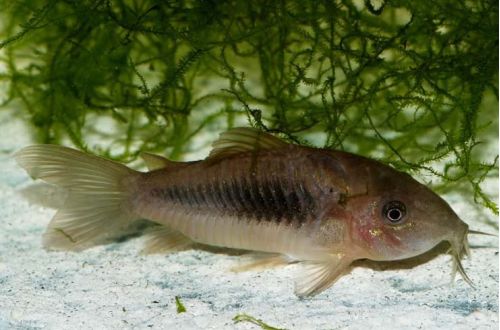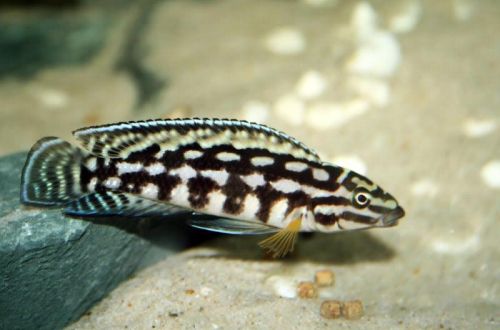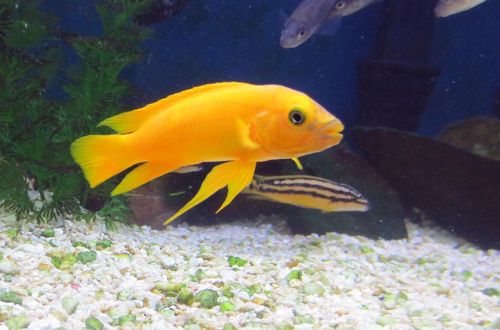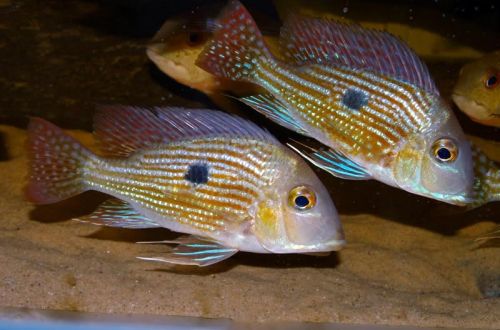
Pindar geophagus
Geophagus pindare, scientific name Geophagus sp. Pindare belongs to the Cichlidae family. The fish got its name from the area in which it was discovered – the river Pindare. Considered relatively easy to keep and breed, it is perfectly compatible with other peaceful fish species of comparable size. In the presence of a spacious aquarium, it can be recommended by an aquarist with little experience.

Contents
Habitat
Comes from South America. It is found only in the basin of the Pindare River (rio Pindare), which flows through the territory of the state of Maranhao in Brazil and flows into the Gulf of St. on the Atlantic coast.
The natural habitat is characterized by clear, brown-colored water. A similar shade is given to it by tannins released from the decomposition of numerous fallen vegetation: branches, leaves, tree trunks, etc. The bottom of the river is sandy with scattered snags, there are few aquatic plants, they grow mainly along the banks.
Brief information:
- The volume of the aquarium – from 300 liters.
- Temperature – 26-29°C
- Value pH — 6.0–7.0
- Water hardness – 1–8 dGH
- Substrate type – sandy
- Lighting – subdued
- Brackish water – no
- Water movement is weak
- The size of the fish is 14–15 cm.
- Food – any sinking food
- Temperament – peaceful
- Content in a group of at least 5–8 individuals
Description
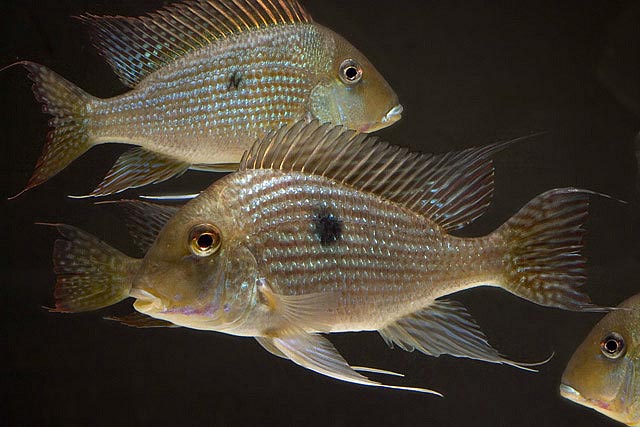
Adult individuals reach a length of 14–15 cm. Sexual dimorphism is weakly expressed, males and females are practically indistinguishable from each other. The fish has a large high body and a large head. The ventral and anal fins have elongated last rays. The dorsal fin resembles a comb, stretching from head to tail. The coloration is silvery blue with rows of narrow horizontal bands of dirty orange. There is a large dark spot in the middle of the body. The fins and tail are reddish with blue hues. Depending on the lighting, the fish may appear just gray with a subtle pattern.
Food
They feed near the bottom by sifting portions of soil with their mouths in search of food particles. Unpretentious, in a home aquarium they will accept any sinking food of a suitable size. Geophagus pindara is accustomed to small pieces of food. The daily diet may consist of dry flakes, granules combined with frozen brine shrimp, daphnia, bloodworm pieces
Maintenance and care, arrangement of the aquarium
Optimal aquarium sizes for a group of 5-8 start at 300 liters. The design is arbitrary and is selected at the discretion of the aquarist. The only important condition is sandy soil, which is necessary for normal nutrition, more on that above. A pair of large flat stones in the future may serve as a place for spawning.
The quality and hydrochemical composition of the water are of paramount importance for the long-term maintenance of this cichlid species. Sharp fluctuations in temperature, pH and dGH parameters, as well as excessive accumulation of products of the nitrogen cycle (nitrites, nitrates, ammonia) should not be allowed. The best way to achieve stable water conditions is to install a productive filtration system and regularly maintain the aquarium with weekly replacement of part of the water (about 50% of the volume) with fresh water.
Behavior and Compatibility
During the spawning period, Geophagus pindare may not be the best neighbors, as they will protect their offspring from any potential danger. Otherwise, they are peaceful calm fish that can get along with many other freshwater species. Aggressive and territorial fish should be avoided. Intraspecific relationships are built on a hierarchy between strong and weak individuals, usually headed by an alpha male. It is recommended to maintain a group size of at least 5–8 fish.
Breeding / breeding
Breeding will not cause great difficulties if you keep the fish in suitable conditions and provide a balanced diet. With the onset of marriage, the male and female form a temporary pair, which, however, can persist for a long time. The couple chooses a place at the bottom suitable for spawning – any flat flat surface, for example, a stone. After fertilization, the male is located at a distance, to guard the approaches to the clutch, the female is in close proximity to the eggs. The incubation period lasts about 3 days, after which the fry that appear immediately find themselves in the female’s mouth, but not to be eaten, but for protection. The juveniles stay in the mouth until they are large enough, periodically swimming out of their “shelter” in search of food. The male sometimes joins this gestation process.
Fish diseases
The main cause of diseases lies in the conditions of detention, if they go beyond the permissible range, then immunity suppression inevitably occurs and the fish becomes susceptible to various infections that are inevitably present in the environment. If the first suspicions arise that the fish is sick, the first step is to check the water parameters and the presence of dangerous concentrations of nitrogen cycle products. Restoration of normal/suitable conditions often promotes healing. However, in some cases, medical treatment is indispensable. Read more about symptoms and treatments in the Aquarium Fish Diseases section.



